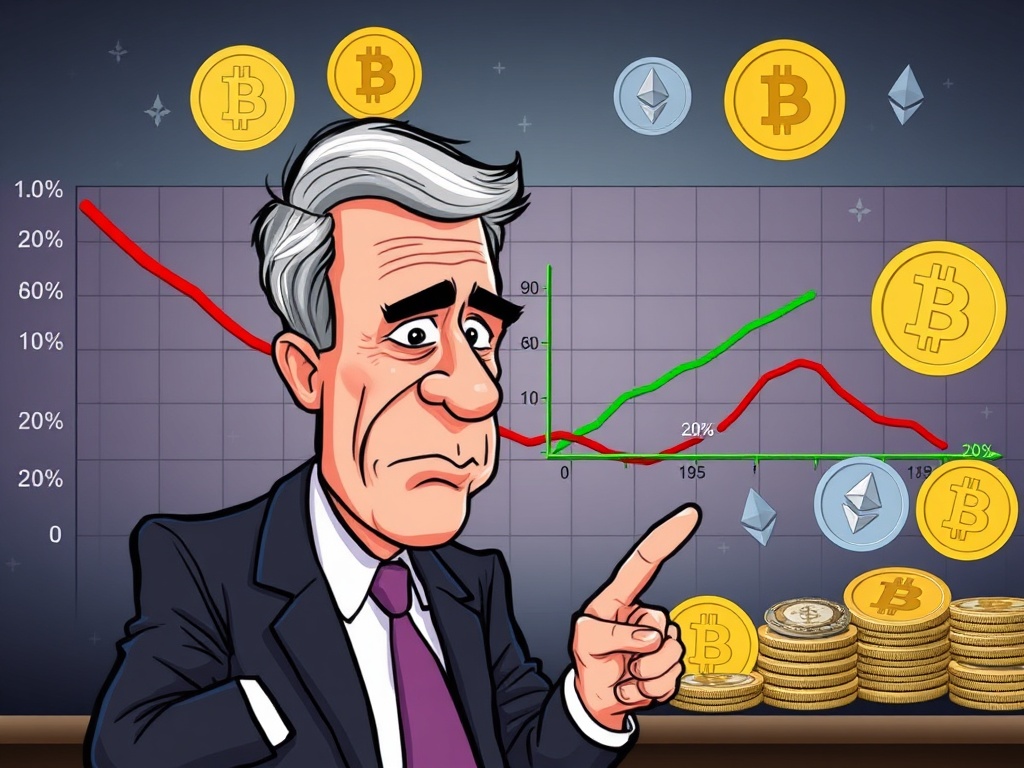BitcoinWorld

Crucial: Fed’s Inflation Target Nears Reality – What It Means for Crypto
The financial world recently buzzed with a significant announcement from Federal Reserve Chairman Jerome Powell: inflation target is much closer to the desired 2% mark. This statement isn’t just a dry economic statistic; it’s a pivotal moment that ripples through every corner of the global economy, including the volatile yet fascinating realm of cryptocurrencies. For investors, traders, and anyone keen on understanding the broader economic landscape, comprehending the implications of this shift is absolutely crucial.
Understanding the Fed’s 2% Inflation Target: Why It Matters
To truly grasp the weight of Powell’s words, we must first understand the Federal Reserve’s mandate and the significance of the 2% inflation target. The Fed has a dual mandate from Congress: to achieve maximum employment and maintain price stability. The 2% inflation rate is considered the sweet spot for price stability, offering a balance between economic growth and preventing the corrosive effects of uncontrolled price increases.
- Price Stability: A low, stable rate of inflation allows businesses and consumers to plan for the future with greater certainty.
- Economic Growth: Too low inflation (or deflation) can discourage spending and investment, while too high inflation erodes purchasing power. The 2% target aims for healthy, sustainable growth.
- Policy Flexibility: Hitting the target gives the Fed more room to maneuver interest rates in response to economic downturns.
For years, particularly since the pandemic, inflation soared, forcing the Fed to embark on an aggressive campaign of interest rate hikes. Now, Powell’s acknowledgment signals that these efforts are bearing fruit, bringing the economy closer to a state of equilibrium.
How Did We Get Here? A Brief Look at the Road to the Inflation Target
The journey to taming inflation has been anything but smooth. Post-pandemic, a perfect storm of factors converged to push prices sky-high:
- Supply Chain Disruptions: Lockdowns and logistics issues severely constrained the supply of goods.
- Surging Demand: Government stimulus packages and pent-up consumer demand fueled spending.
- Labor Shortages: A tight labor market led to wage increases, contributing to higher production costs.
- Geopolitical Events: Conflicts, like the war in Ukraine, impacted energy and food prices globally.
In response, the Federal Reserve initiated a series of rapid interest rate increases, making borrowing more expensive to cool down economic activity and reduce demand. This strategy, while painful for some sectors, was designed to bring inflation back to its long-term inflation target.
What Does a Nearing Inflation Target Mean for Traditional Markets?
The implications for traditional financial markets are profound. A stable inflation outlook often suggests that the Fed may pause or even begin to cut interest rates in the future. Here’s a quick overview of potential impacts:
| Asset Class | Potential Impact | Reasoning |
|---|---|---|
| Stocks | Potentially Positive | Lower interest rates reduce borrowing costs for companies and make future earnings more valuable, boosting valuations. |
| Bonds | Mixed to Positive | Existing bonds with higher yields become more attractive if new bond yields fall. Lower inflation reduces erosion of bond value. |
| Real Estate | Potentially Positive | Lower mortgage rates can stimulate housing demand and affordability. |
However, it’s important to remember that markets are complex, and many other factors are always at play.
The Crypto Connection: How Does the Inflation Target Affect Digital Assets?
This is where it gets particularly interesting for our audience. Cryptocurrencies, especially Bitcoin, gained significant traction as an ‘inflation hedge’ during periods of high inflation. The narrative was that a decentralized, finite asset like Bitcoin could protect wealth from the debasement of fiat currencies. But what happens when the inflation target is almost met?
Is the ‘Inflation Hedge’ Narrative Still Strong for Crypto?
When inflation is high, investors often seek alternative assets. As the Fed brings inflation under control, the urgency for an inflation hedge might diminish. This could lead to a reassessment of Bitcoin’s primary use case for some investors. However, it doesn’t invalidate crypto’s other fundamental value propositions, such as decentralization, censorship resistance, and technological innovation.
The Impact of Potential Rate Cuts on Crypto Liquidity
If the Fed indeed pivots to rate cuts in the future, it generally signals a more accommodative monetary policy. This typically means:
- Increased Liquidity: Lower interest rates make it cheaper to borrow money, potentially freeing up more capital that could flow into riskier assets like cryptocurrencies.
- Risk-On Sentiment: A less restrictive monetary environment often fosters a ‘risk-on’ sentiment among investors, encouraging them to allocate more to higher-growth, higher-volatility assets.
- Reduced Dollar Strength: Lower interest rates can weaken the U.S. dollar, which historically has an inverse relationship with Bitcoin’s price. A weaker dollar makes dollar-denominated assets like Bitcoin more attractive to international buyers.
So, while the direct ‘inflation hedge’ argument might soften, the broader economic conditions fostered by achieving the inflation target could be quite bullish for crypto due to increased liquidity and risk appetite.
Challenges and Uncertainties on the Path to the Sustained Inflation Target
While Powell’s statement is optimistic, the path to a sustained 2% inflation target is not without its hurdles. Several factors could still derail progress:
- Geopolitical Instability: New conflicts or escalations could disrupt supply chains and commodity markets, reigniting inflationary pressures.
- Energy Price Volatility: Spikes in oil or gas prices could feed into broader inflation.
- Labor Market Resilience: A persistently tight labor market with strong wage growth could keep services inflation elevated.
- Second-Round Effects: Businesses might continue to pass on higher costs to consumers, creating a cycle of price increases.
The Fed remains data-dependent, meaning future policy decisions will hinge on incoming economic data, not just a single statement.
Actionable Insights for Crypto Investors
Given the evolving economic landscape, what should crypto investors consider?
- Diversify Your Portfolio: Don’t put all your eggs in one basket. While crypto offers unique opportunities, a balanced portfolio can mitigate risks.
- Stay Informed: Keep a close eye on economic indicators, Fed announcements, and global events. These will continue to influence market sentiment.
- Understand the Narratives: Be aware of why people are buying crypto. Is it for speculation, long-term belief in the technology, or a hedge? As economic conditions change, so do these narratives.
- Long-Term Vision: For many, the underlying technology and transformative potential of blockchain remain the primary drivers for crypto adoption, irrespective of short-term economic cycles.
The journey towards the 2% inflation target is a marathon, not a sprint, and its implications for crypto are multifaceted.
A Compelling Outlook: The Future Shaped by the Inflation Target
Jerome Powell’s statement marks a significant milestone in the fight against inflation. It signals that the economy is moving towards a more stable environment, potentially paving the way for future interest rate adjustments that could benefit risk assets, including cryptocurrencies. While the ‘inflation hedge’ narrative for crypto may evolve, the broader implications of increased liquidity and a more predictable economic climate could create fertile ground for the digital asset space. As always, informed decision-making and a clear understanding of both macroeconomic trends and specific asset fundamentals will be key to navigating the opportunities ahead.
Frequently Asked Questions (FAQs)
Q1: What is the Federal Reserve’s 2% inflation target?
A1: The Federal Reserve aims for an average annual inflation rate of 2% as measured by the Personal Consumption Expenditures (PCE) price index. This target is considered optimal for achieving price stability and supporting maximum sustainable employment in the economy.
Q2: How does reaching the inflation target impact interest rates?
A2: When the Federal Reserve believes inflation is sustainably moving towards or has reached its 2% target, it may consider pausing interest rate hikes or even beginning to cut rates. Lower rates make borrowing cheaper, which can stimulate economic activity but also influence asset prices.
Q3: Is Bitcoin still a good inflation hedge if the inflation target is met?
A3: The narrative of Bitcoin as an ‘inflation hedge’ may become less prominent if inflation is under control. However, Bitcoin and other cryptocurrencies possess other fundamental characteristics, such as decentralization and scarcity, which continue to appeal to investors regardless of inflation levels. Their value proposition extends beyond just hedging against inflation.
Q4: What are the main risks that could prevent the Fed from sustaining the 2% inflation target?
A4: Several risks could challenge the sustained achievement of the 2% inflation target. These include unforeseen geopolitical events that disrupt supply chains, unexpected spikes in commodity prices (like oil), or a persistently tight labor market leading to wage-price spirals. The Fed constantly monitors these factors.
Q5: How should crypto investors adjust their strategy based on the inflation target news?
A5: Crypto investors should prioritize staying informed about macroeconomic developments and the Fed’s monetary policy. While a stable inflation environment might reduce the ‘hedge’ demand, potential rate cuts could increase liquidity and risk appetite, benefiting crypto. Diversification, long-term vision, and understanding crypto’s core value propositions beyond just inflation hedging are crucial.
If you found this article insightful, please consider sharing it with your network! Your support helps us continue providing valuable analysis on the intersection of traditional finance and the exciting world of cryptocurrencies.
To learn more about the latest crypto market trends, explore our article on key developments shaping Bitcoin price action.
This post Crucial: Fed’s Inflation Target Nears Reality – What It Means for Crypto first appeared on BitcoinWorld and is written by Editorial Team





